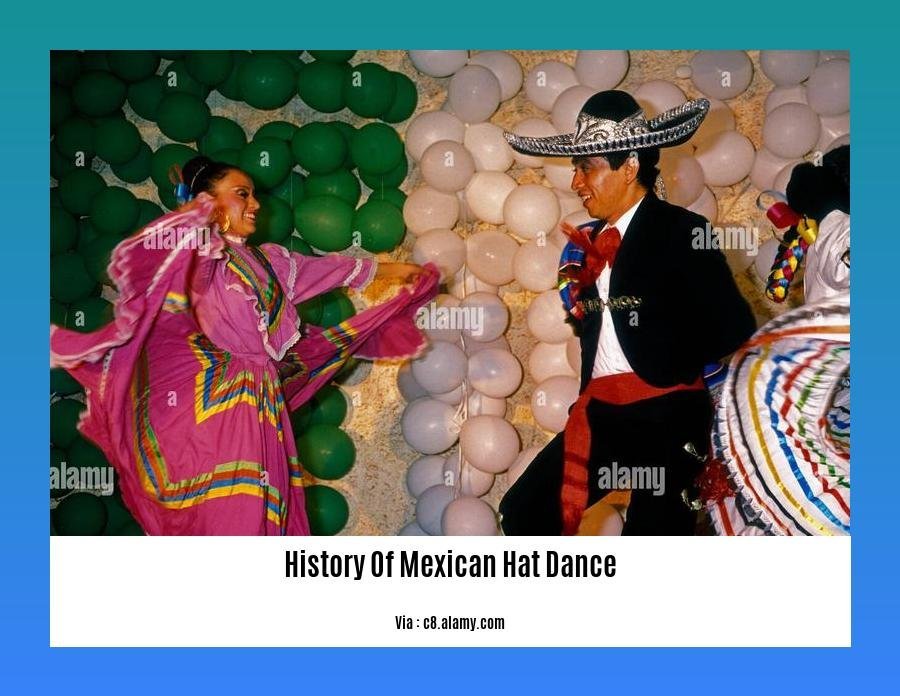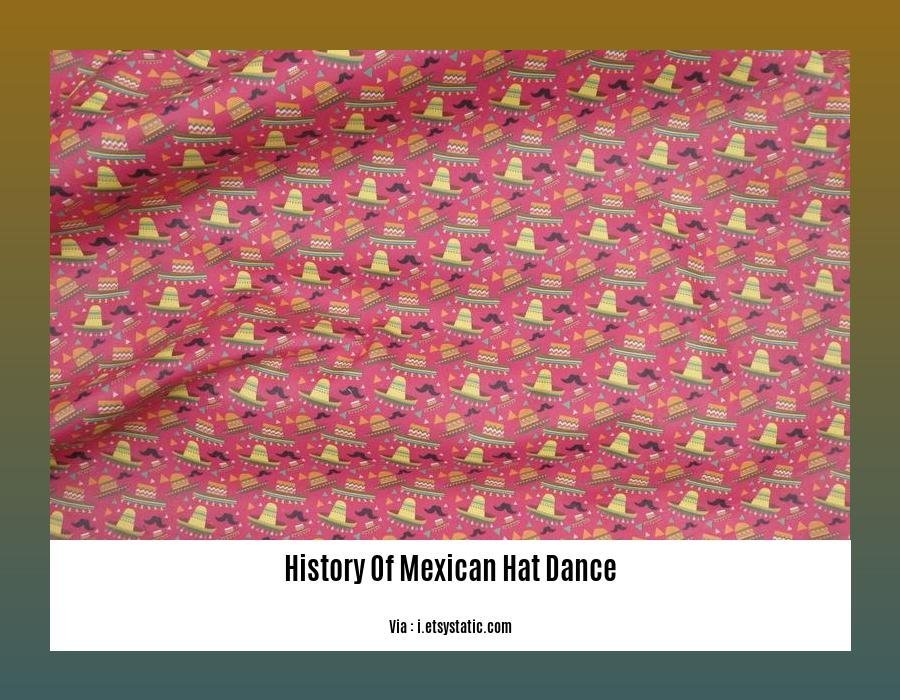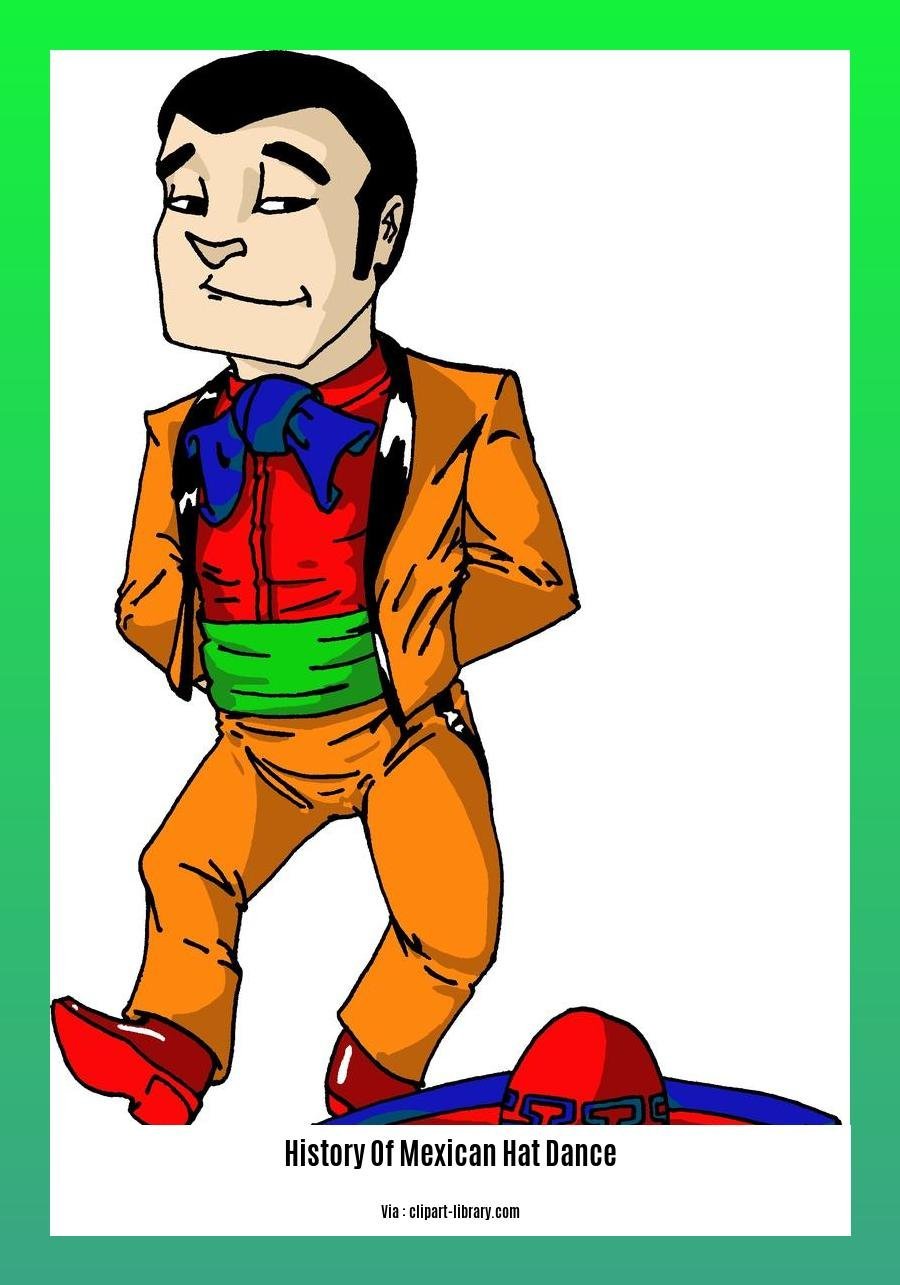Step into the vibrant world of Mexican folk dance as we unveil the captivating history of Jarabe Tapatío, also known as the Mexican hat dance. This iconic dance, deeply rooted in the rich cultural heritage of Mexico, has captivated audiences worldwide with its mesmerizing footwork, graceful movements, and the expressive use of sombreros. Join us on a captivating journey into the origins, evolution, and cultural significance of this beloved dance, uncovering the stories and traditions that have shaped its enduring legacy.
Key Takeaways:
- Jarabe Tapatío, the Mexican hat dance, originated in Guadalajara, Jalisco, Mexico, during the 19th century.
- It is rooted in Spanish zambra and jarabe gitano from the colonial era.
- The name Jarabe Tapatío is derived from the Arabic word “xarab,” meaning “herb mixture” or “syrup,” suggesting a combination of elements.
- The dance represents courtship, with the woman initially rejecting the man’s advances before eventually accepting.
- In the United States, Jarabe Tapatío performance troupes are gaining popularity, fostering reconnections within Mexican communities.
History of Mexican Hat Dance

Centuries ago, in the vibrant streets of Guadalajara, Jalisco, Mexico, a captivating dance emerged, enchanting hearts with its graceful movements and infectious rhythm. This dance, known as Jarabe Tapatío or the Mexican Hat Dance, has become an iconic symbol of Mexican culture, a captivating spectacle that weaves together history, tradition, and artistry. Let’s delve into the rich history of the Mexican hat dance and discover the cultural significance that makes it an enduring treasure.
Origins of the Mexican Hat Dance
The roots of the Mexican hat dance can be traced back to the vibrant era of the 19th century in Guadalajara, a city renowned for its artistic and cultural expressions. During this period, the dance emerged as a blend of Spanish and indigenous influences, drawing inspiration from the traditional Spanish zambra and the lively jarabe gitano, a dance brought to Mexico by Spanish settlers.
The Name: A Tale of Cultural Fusion
The intriguing name “Jarabe Tapatío” holds a fascinating story of cultural fusion. It is believed that the word “jarabe” originates from the Arabic term “xarab,” meaning “herb mixture” or “syrup.” This etymology suggests a harmonious blend of elements, akin to the fusion of diverse cultural influences that gave birth to this captivating dance.
Courtship Ritual: A Dance of Love and Rejection
At its core, the Mexican hat dance portrays a captivating tale of courtship, where a persistent suitor woos a reluctant señorita. The dance begins with the man’s graceful advances, which are initially met with resistance from the woman. However, as the dance progresses, the woman’s heart begins to soften, and she eventually succumbs to the allure of the suitor’s charm, accepting his invitation to dance.
Mexican Hat Dance in the United States: A Cultural Bridge
The Mexican hat dance has transcended borders, capturing hearts and imaginations in the United States as well. Performance troupes dedicated to preserving and showcasing this iconic dance have gained popularity, fostering a sense of reconnection within Mexican communities and sharing the vibrant heritage of Mexico with a broader audience.
The Enduring Legacy: A Symbol of Mexican Pride
Today, the Mexican hat dance stands as a cherished symbol of Mexican pride and cultural identity. It is performed at countless festivals, celebrations, and cultural events, captivating audiences with its infectious energy and vibrant choreography. The dance has become a beloved tradition, passed down from generation to generation, ensuring that the legacy of Jarabe Tapatío will continue to inspire and enchant for years to come.
If you’re interested in how Jamaica came to exist, take a look at the history of Jamaica. From the time of its inhabitants until today, you’ll learn a timeline of its transformation through this history timeline.
The history of the Malankara Orthodox Church is an exciting journey of faith and tradition. Embark on this spiritual expedition to uncover the history of the Malankara Orthodox Church and its enduring legacy from its ancient roots to its modern-day significance.
Discover the vibrant history of Mexican clothing, a captivating fusion of indigenous traditions and global influences. From ancient Aztec textiles to contemporary fashion, explore the evolution of Mexican clothing and its enduring impact on global style.
Immerse yourself in the rhythmic heart of Mexico’s musical heritage. Uncover the captivating history of Mexican music, from ancient indigenous melodies to the infectious rhythms of mariachi bands, and experience the vibrant tapestry of sounds that have shaped a nation’s soul.
Symbolism and Cultural Significance of Jarabe Tapatío
Cultural Roots:
– Originating in the vibrant cultural fusion of Guadalajara, Jarabe Tapatío is a dance seeped in symbolism, embodying a rhythmic representation of Mexican heritage.
– Its choreography, costumes, and music interweave indigenous, Spanish, and French influences, paying homage to Mexico’s diverse cultural lineage.
Courtship Ritual:
– The Jarabe Tapatío mesmerizes audiences as a lively display of courtship, embodying the romantic pursuit of a persistent suitor wooing a reluctant señorita.
– Through intricate footwork and graceful movements, the dance narrates the evolution of their relationship, culminating in acceptance and a shared dance.
Unity and National Pride:
– As the national dance of Mexico, the Jarabe Tapatío stands as a symbol of national unity and pride.
– Its performance during festive occasions like Independence Day showcases the richness and vibrancy of Mexican culture, resonating with audiences both at home and abroad.
Symbolism of the Hat:
– The sombrero, an integral part of the dance, symbolizes more than just a cultural icon.
– In the context of the Jarabe Tapatío, it represents both the male suitor’s determination and the allure of the female figure he pursues.
Cultural Significance:
– Beyond its captivating performance, the Jarabe Tapatío holds deep cultural significance, representing:
– A Celebration of Mexican identity and heritage
– A testament to the country’s vibrant dance traditions
– A symbol of national unity and pride
– A cherished tradition passed down through generations
Key Takeaways:
- Jarabe Tapatío originated in Guadalajara, combining indigenous, Spanish, and French cultural influences.
- It depicts a courtship ritual, symbolizing a suitor’s persistent pursuit of a reluctant señorita.
- The dance represents national unity, showcased during festive occasions like Independence Day.
- The sombrero symbolizes the suitor’s determination and the allure of the señorita.
- Jarabe Tapatío embodies Mexican identity, dance traditions, national pride, and cherished heritage.
References:
Jarabe Tapatío – Wikipedia
JARABE TAPATIO DANCE – MEXICO
Variations and Regional Adaptations of the Dance in Different Parts of Mexico

Mexican folk dance, like a vibrant mosaic, is a reflection of Mexico’s rich cultural diversity, embracing unique dance styles and costumes from various regions. Let’s delve into the captivating variations and regional adaptations of the Mexican hat dance that have emerged across the country:
1. The Southern Allure of Veracruz
The coastal state of Veracruz brings its own flavor to the Jarabe Tapatío, characterized by graceful and sensual movements, accompanied by the rhythmic strumming of the jarana, a traditional string instrument. The women’s skirts, adorned with intricate embroidery, twirl and sway, echoing the gentle waves of the Gulf of Mexico.
2. The Majestic Dance of Jalisco
In the heart of Mexico, Jalisco, the birthplace of the Jarabe Tapatío, showcases a vibrant and energetic version of the dance. The men, with their charro hats and colorful trajes de charro, perform impressive footwork, demonstrating their strength and agility. The women, adorned in colorful skirts and blouses, complement their partners with graceful and elegant movements.
3. The Enchanting Charm of Oaxaca
The southern state of Oaxaca, renowned for its indigenous heritage, infuses the Jarabe Tapatío with a unique blend of traditions. The intricate footwork and rhythmic stamping, accompanied by the soulful melodies of traditional instruments, create a captivating spectacle that celebrates the region’s rich cultural legacy.
4. The Lively Rhythms of Michoacán
Michoacán, with its diverse landscapes and traditions, brings a lively and upbeat version of the Jarabe Tapatío to the dance floor. The music, featuring the infectious rhythms of the pirekua, a traditional song style, fills the air as dancers twirl and spin, showcasing their joy and enthusiasm.
5. The Romantic Elegance of Guanajuato
In the picturesque state of Guanajuato, the Jarabe Tapatío exudes a touch of elegance and romance. The dancers, dressed in elaborate and colorful costumes, glide across the dance floor with grace and precision. The women’s flowing skirts, twirling in perfect harmony with the men’s intricate footwork, create a mesmerizing spectacle.
Key Takeaways:
- Regional Adaptations: Each region of Mexico has its own unique style of Jarabe Tapatío, reflecting the diverse cultural heritage and traditions of the country.
- Costumes and Music: Variations in costumes, music, and instruments accompany the dance, showcasing the region’s distinct cultural identity.
- Footwork and Movements: The dance showcases a range of footwork and movements, from graceful and sensual to energetic and lively, depending on the region.
- Cultural Significance: The Jarabe Tapatío, with its regional variations, represents the rich cultural diversity of Mexico, fostering a sense of national pride and identity.
Sources:
- MomentsLog: The Richness of Mexican Folklorico Dance
- Britannica: Latin American Dance – Mexico
Jarabe Tapatío as a Representation of Mexican National Identity
Picture this: a vibrant dance floor, pulsating with the rhythm of traditional Mexican music. As the spotlight illuminates the stage, a pair of dancers, adorned in colorful costumes, take their positions. The man, dressed in a charro suit, his sombrero perched proudly atop his head, and the woman, her full skirt swirling gracefully, prepare to showcase the iconic Jarabe Tapatío.
This captivating dance, also known as the Mexican hat dance, is an embodiment of Mexican national identity, a living testament to the country’s rich cultural heritage. Its origins can be traced back to the 19th century, where it emerged in Guadalajara, Jalisco, as a courtship dance.
Over time, the Jarabe Tapatío evolved into a symbol of national unity, celebrating the fusion of indigenous and Spanish influences that shaped Mexico’s cultural tapestry. The dance is characterized by its intricate footwork, graceful movements, and the skillful manipulation of the sombrero, which becomes an extension of the dancer’s body, adding a touch of playful charm to the performance.
As the Jarabe Tapatío gained popularity, it spread throughout Mexico, becoming an integral part of fiestas, celebrations, and cultural events. Its infectious rhythm and lively choreography resonated with audiences across the country, solidifying its place as a symbol of Mexican identity.
Today, the Jarabe Tapatío remains a beloved tradition, performed by professional dance companies and local communities alike. It is a testament to Mexico’s enduring cultural spirit, showcasing the country’s pride, passion, and unwavering connection to its roots.
Key Takeaways:
- The Jarabe Tapatío, also known as the Mexican hat dance, is a symbol of Mexican national identity.
- Originating in Guadalajara, Jalisco, it emerged as a courtship dance in the 19th century.
- The dance fuses indigenous and Spanish influences, reflecting Mexico’s rich cultural heritage.
- It is characterized by intricate footwork, graceful movements, and the skillful use of the sombrero.
- The Jarabe Tapatío has become an integral part of Mexican fiestas, celebrations, and cultural events.
Sources:
FAQ
Q1: What are the origins of the Mexican hat dance?
A1: The Mexican hat dance, known as Jarabe Tapatío, originated in Guadalajara, Jalisco, Mexico, during the 19th century. Rooted in Spanish zambra and jarabe gitano from the colonial era, its name derives from the Arabic word “xarab,” which means “herb mixture” or “syrup,” suggesting a combination of elements.
Q2: What is the significance of the Mexican hat dance?
A2: The Mexican hat dance, Jarabe Tapatío, symbolizes national identity and unity. It celebrates Mexican music, dance, and folklore, showcasing the country’s rich cultural heritage. The dance is often performed during festive occasions like Mexican Independence Day and is recognized as an important part of Mexico’s cultural heritage.
Q3: How is the Mexican hat dance typically performed?
A3: Traditionally, the Mexican hat dance, Jarabe Tapatío, is performed by a man and a woman. The dance incorporates intricate footwork, graceful movements, and the use of colorful costumes, including the iconic wide-brimmed sombrero (hat) and a full skirt. The man typically wears a charro suit, a traditional Mexican attire, and executes impressive moves like spins, jumps, and zapateo (foot tapping), while the woman showcases her elegance through graceful turns and skirt work.
Q4: What are some variations of the Mexican hat dance?
A4: The jarabe tapatío has evolved over time and now has several variations, each presenting unique regional styles influenced by the rich cultural diversity of Mexico. Some variations include the Jarabe Tapatío de Jalisco, which is the most popular and widely recognized, as well as regional variations from states like Veracruz, Puebla, and Yucatán, each with its distinct choreography and music.
Q5: Why is the Mexican hat dance so popular?
A5: The popularity of the Mexican hat dance, Jarabe Tapatío, can be attributed to its captivating music, vibrant costumes, and energetic choreography. It is a symbol of Mexican pride and national identity, often performed at cultural events, festivals, and celebrations. The dance’s popularity has also been boosted by its inclusion in popular culture, such as movies, TV shows, and stage performances, which have showcased its unique charm and appeal to a global audience.
- Red Cloud, NE: Discover Willa Cather’s Legacy - April 11, 2025
- Remember Old Social Media Sites? Their Rise and Fall - April 11, 2025
- How many days till Feb 3?Accurate Countdowns & Tools - April 11, 2025
















